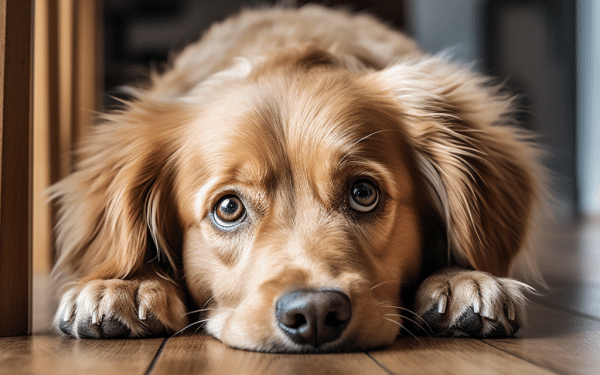Separation Anxiety in Dogs: Expert Strategies

Separation anxiety in dogs is a common and distressing condition that many pet owners face. When left alone, dogs with separation anxiety can exhibit behaviors such as excessive barking, destructive chewing, and bathroom accidents. This can be challenging for both the dog and the owner.
To ease separation anxiety in dogs, it is important to seek expert advice and implement effective strategies. With the right support and understanding, dogs can learn to cope with being alone and experience a sense of ease. In this article, we will explore various techniques and preventive measures that can help alleviate separation anxiety in dogs.
Whether you are a dog owner or someone working in an animal shelter, this comprehensive guide will provide valuable insights and practical solutions to help both you and your furry friend navigate through this difficult situation. Let’s dive in and discover the expert advice that can make a difference in easing separation anxiety in dogs.

Understanding Separation Anxiety in Dogs
Separation anxiety is a common problem in dogs that can lead to various symptoms and behavior issues. When dogs experience separation anxiety, they may exhibit excessive barking, howling, and pacing. They may also engage in destructive behavior and have accidents in the house when left alone. It is important for dog owners to understand the signs and symptoms of separation anxiety in order to provide appropriate support and treatment for their furry friends.
Dogs experiencing separation anxiety may exhibit the following symptoms:
- Excessive barking and howling
- Pacing back and forth
- Destructive behavior, such as chewing furniture or scratching walls
- Bathroom accidents in the house
These symptoms are often a result of the stress and anxiety dogs feel when their owners leave them alone. Dogs are social animals and thrive on companionship, so being left alone can be distressing for them. It is important for dog owners to recognize these signs and seek appropriate treatment to help their dogs cope with separation anxiety.
Understanding separation anxiety in dogs is the first step towards providing the necessary support and care. By acknowledging and addressing this condition, dog owners can help their furry friends live happier, more balanced lives.
Risk Factors for Separation Anxiety
Separation anxiety in dogs can be influenced by various risk factors, including genetic and environmental factors. Understanding these factors can help dog owners identify potential causes and take appropriate preventive measures.
Genetic Factors
Research suggests that dogs with anxious parents are more likely to develop separation anxiety. Genetic predisposition can play a role in the development of this condition, making certain dogs more susceptible than others. While genetics alone may not be the sole cause of separation anxiety, it can contribute to its onset.
Environmental Factors
Changes in the environment can also trigger separation anxiety in dogs. Major life events such as moving to a new home or the loss of a family member can disrupt a dog’s routine and sense of security, leading to increased anxiety when left alone. These environmental changes can have a significant impact on a dog’s emotional well-being and behavior.
Other Factors
In addition to genetic and environmental factors, there may be other individual factors that contribute to separation anxiety in dogs. These factors can vary from dog to dog and may include previous traumatic experiences, lack of socialization, or a history of abandonment or neglect. It is important to consider all potential factors when addressing separation anxiety in dogs.
| Risk Factors | Description |
|---|---|
| Genetic Factors | Dogs with anxious parents are more likely to develop separation anxiety. |
| Environmental Factors | Changes in the environment, such as moving or the loss of a family member, can trigger separation anxiety. |
| Other Factors | Individual factors such as previous traumatic experiences or lack of socialization can contribute to separation anxiety. |
By understanding these risk factors, dog owners can take proactive steps to prevent or mitigate separation anxiety in their beloved pets. Creating a calm and supportive environment, providing appropriate training and socialization, and seeking professional guidance when needed can all contribute to helping dogs cope with separation anxiety.
Preventive Measures for Separation Anxiety
When it comes to preventing separation anxiety in dogs, there are several proactive measures that dog owners can take. By implementing these preventive strategies, owners can help their furry friends feel more secure and comfortable when left alone.
Create a Consistent Routine
Establishing a consistent routine can be beneficial in reducing separation anxiety in dogs. Dogs thrive on predictability, so sticking to a regular schedule for feeding, exercise, and alone time can help them feel more at ease. By providing a structured and predictable environment, dogs are less likely to experience anxiety when their owners are away.
Gradual Departure Training
Gradual departure training is an effective technique for helping dogs become accustomed to being alone. This involves desensitizing the dog to the departure cues, such as picking up keys or putting on shoes, that trigger anxiety. By gradually increasing the duration of time spent away, starting with short intervals and gradually working up to longer periods, dogs can learn to feel more secure and relaxed during their owner’s absence.
Provide Mental Stimulation
Keeping dogs mentally stimulated can help ward off separation anxiety. Interactive toys and puzzles can provide mental engagement and occupy their attention while alone. This not only helps distract them from any anxiety they may be feeling but also promotes mental exercise and overall well-being. Additionally, providing a safe and comfortable environment with cozy bedding and familiar scents can help dogs feel more secure in their surroundings.
Table: Preventive Measures for Separation Anxiety
| Preventive Measures | Description |
|---|---|
| Create a Consistent Routine | Establish a predictable schedule for feeding, exercise, and alone time to reduce anxiety. |
| Gradual Departure Training | Desensitize the dog to departure cues and gradually increase the duration of time spent alone. |
| Provide Mental Stimulation | Use interactive toys and puzzles to keep the dog mentally engaged and provide a comfortable environment. |
Effective Treatments for Separation Anxiety
When it comes to treating separation anxiety in dogs, there are various options available that can help alleviate their stress and improve their overall well-being. Two primary treatment avenues for separation anxiety in dogs are medication and behavioral therapy. These approaches can be used individually or in combination, depending on the severity of the dog’s condition and the recommendation of a veterinarian or certified dog behaviorist.
Medication can play a crucial role in managing separation anxiety in dogs. One commonly prescribed medication is Trazadone, which is used to reduce anxiety and promote relaxation. It can be administered prior to anticipated periods of separation to help dogs feel calmer. However, it is important to consult with a veterinarian to determine the appropriate dosage and duration of medication, as well as to monitor any potential side effects.
Behavioral therapy is another effective treatment approach for separation anxiety in dogs. Techniques such as desensitization and counterconditioning can help dogs gradually acclimate to being alone and develop more positive associations with their owners’ departures. These techniques involve exposing the dog to gradually increasing periods of alone time, paired with positive reinforcement and rewards. Working with a certified dog behaviorist can provide invaluable guidance and support in implementing these behavioral modification strategies.
Table: Comparison of Medication and Behavioral Therapy for Separation Anxiety
| Treatment Approach | Key Benefits | Considerations |
|---|---|---|
| Medication | – Can help reduce anxiety and promote relaxation – Provides short-term relief |
– Requires consultation with a veterinarian – Potential side effects and dosage adjustments |
| Behavioral Therapy | – Helps dogs develop coping mechanisms and positive associations – Can lead to long-term behavioral changes |
– Requires time, consistency, and patience – May require assistance from a certified dog behaviorist |
“Both medication and behavioral therapy can be effective in treating separation anxiety in dogs. It is important to consider the individual needs of each dog and work closely with a veterinarian or certified dog behaviorist to determine the most suitable treatment plan.”
It is worth noting that separation anxiety in dogs can vary in severity, and what works for one dog may not be effective for another. Therefore, a personalized approach is essential to address each dog’s unique needs. Alongside medication and behavioral therapy, supportive measures such as environmental enrichment and a consistent routine can also contribute to the overall well-being of dogs with separation anxiety.
Breeds Prone to Separation Anxiety
While all dogs can experience separation anxiety, certain breeds are more prone to this condition. It is important for dog owners considering these breeds to be aware of the increased risk and be prepared to provide extra attention, training, and support to help their dogs cope with being alone.
Here are some breeds that are known to be more susceptible to separation anxiety:
- Chihuahuas
- Cockerpoos
- Labradoodles
- Jack Russell Terriers
- Golden Retrievers
- Border Collies
- Vizlas
- Dalmations
- German Shepherds
- Bichon Frises
These breeds may have certain characteristics or temperaments that make them more prone to anxiety when left alone. Owners of these breeds should be mindful of their dogs’ needs and provide appropriate support to help them feel secure in their absence.
| Breed | Characteristics | Tips for Coping |
|---|---|---|
| Chihuahuas | Small size, loyal, prone to attachment | Gradual desensitization, crate training |
| Golden Retrievers | Friendly, social, energetic | Physical exercise, mental stimulation, interactive toys |
| German Shepherds | Intelligent, protective, strong bond with owners | Obedience training, structured routine, calming supplements |
Understanding the specific needs and characteristics of these breeds can help dog owners tailor their approach to addressing separation anxiety. With proper care, training, and support, dogs of these breeds can learn to manage their anxiety and lead happy, balanced lives.
Symptoms of Separation Anxiety in Dogs
When a dog experiences separation anxiety, they may exhibit a range of symptoms that can indicate their distress. It’s important for dog owners to be aware of these symptoms so they can identify the problem and seek appropriate help. Some common symptoms of separation anxiety in dogs include:
- Whining or excessive vocalization
- Pacing back and forth
- Excessive salivating
- Urinating in the house, even when house-trained
These symptoms can be distressing for both the dog and their owner. They often occur when the dog is left alone or separated from their owner, and they may intensify as the duration of separation increases. Recognizing these symptoms early on can help in implementing proper treatment and coping strategies to alleviate the dog’s anxiety and improve their overall well-being.
If you notice any of these symptoms in your dog, it’s important to consult with a veterinarian or a certified dog behaviorist. They can assess the situation, confirm if separation anxiety is the underlying issue, and develop a personalized treatment plan tailored to your dog’s specific needs.
It’s important to remember that these symptoms may not necessarily indicate separation anxiety and could be the result of other underlying health or behavioral issues. Consulting with a professional can help determine the root cause and provide the best course of action.
Coping Strategies for Dogs with Separation Anxiety
Dogs with separation anxiety can experience significant distress when left alone. Fortunately, there are several coping strategies that dog owners can employ to help their furry friends feel more comfortable and secure in their absence.
1. Crate Training
Crate training is a popular method for helping dogs with separation anxiety. The key is to introduce the crate gradually and create positive associations with it. Start by leaving the crate open and placing treats or toys inside to encourage your dog to explore it. Once your dog is comfortable entering the crate, gradually increase the duration they spend inside, always providing a safe and comfortable environment.
2. Interactive Toys
Interactive toys can be a great source of mental stimulation and distraction for dogs with separation anxiety. Look for toys that require problem-solving or provide treats when manipulated. These toys can help keep your dog engaged and occupied, redirecting their attention away from their anxiety and onto the interactive play.
3. Establish a Consistent Routine
Dogs with separation anxiety thrive on routine and predictability. Establishing a consistent daily schedule can help reduce their anxiety. Try to feed, walk, and play with your dog at the same times each day. When it comes to leaving the house, practice gradual departures—start with short periods of time and gradually increase the duration as your dog becomes more comfortable being alone.
By implementing these coping strategies, dog owners can provide their furry friends with the support and tools they need to manage separation anxiety and feel more at ease when alone.
| Coping Strategies for Dogs with Separation Anxiety | |
|---|---|
| Crate Training | Introduce the crate gradually, creating positive associations. Increase the duration gradually. |
| Interactive Toys | Provide mental stimulation and distraction with toys that require problem-solving or provide treats. |
| Establish a Consistent Routine | Stick to a regular schedule for feeding, walking, and playtime. Practice gradual departures when leaving. |
Supportive Measures for Dogs with Separation Anxiety
When it comes to helping dogs with separation anxiety, there are several supportive measures that can be taken to alleviate their stress and promote a sense of calm. These measures include the use of calming supplements and environmental enrichment.
Calming Supplements
Calming supplements, such as pheromone diffusers or natural remedies, can be effective in soothing anxious dogs. Pheromone diffusers release synthetic pheromones that mimic those produced by nursing mother dogs, creating a sense of comfort and security. Natural remedies, such as chamomile or lavender, can also have a calming effect on dogs. It is important to consult with a veterinarian before introducing any supplements to ensure they are safe and suitable for your dog.
Environmental Enrichment
Creating a stimulating and comforting environment for dogs with separation anxiety can greatly aid in their overall well-being. Providing comfortable bedding, soothing music, and creating a safe space with their favorite toys can help distract dogs from their anxiety and create a positive association with being alone. Interactive toys and puzzles can also keep dogs mentally stimulated and prevent boredom, which can contribute to their anxiety. Each dog is unique, so it is important to experiment with different forms of environmental enrichment to find what works best for your furry friend.
Quote: “Calming supplements and environmental enrichment can play a valuable role in supporting dogs with separation anxiety and helping them feel more secure when left alone.” – Dr. Emily Thompson, Veterinarian
By implementing supportive measures such as calming supplements and environmental enrichment, dog owners can provide their furry friends with the extra support they need to cope with separation anxiety. These measures, in combination with other preventive and treatment strategies, can help alleviate stress and promote a happier and more balanced life for dogs affected by separation anxiety.
| Supportive Measures | Description |
|---|---|
| Calming Supplements | Includes pheromone diffusers and natural remedies to soothe anxious dogs. |
| Environmental Enrichment | Provides a comforting and stimulating environment through bedding, music, toys, and puzzles. |
Professional Help for Dogs with Separation Anxiety
Many dog owners can manage separation anxiety with preventive measures and support, but some dogs may need professional help. Consult a vet or dog behaviorist for expert advice and tailored treatment.
A veterinarian specializing in behavior can assess the dog’s overall health and rule out any underlying medical conditions that may contribute to their anxiety. They may also recommend medication, such as anti-anxiety drugs, to help alleviate the dog’s symptoms and promote a sense of calmness. Additionally, a qualified dog behaviorist can work closely with the dog and their owner to implement behavior modification techniques that address the root causes of separation anxiety.
Working with a professional can offer dog owners personalized strategies to manage and reduce their pet’s separation anxiety. It’s important to remember that each dog is unique, and what works for one may not work for another. A professional can provide guidance on creating a structured routine, implementing gradual desensitization techniques, and offering mental and physical stimulation to help the dog cope with being alone.
“Seeking professional help can be a game-changer for dogs with severe separation anxiety. With the right guidance and treatment, these dogs have a better chance of living a more balanced and stress-free life.”
Remember, overcoming separation anxiety is a process that requires patience and consistency. Professional assistance can provide the necessary expertise and support to help dogs and their owners navigate this challenging condition, leading to improved well-being for both.
| Benefits of Professional Help for Dogs with Separation Anxiety |
|---|
| Customized treatment plans based on individual needs |
| Access to behavioral medication if necessary |
| Expert guidance in implementing behavior modification techniques |
| Improved mental well-being for both dogs and owners |
| Increased chances of successful long-term management of separation anxiety |
Long-term Management of Separation Anxiety
Managing separation anxiety in dogs requires a comprehensive, long-term approach that combines behavior modification techniques and supportive care. By implementing these strategies, dog owners can help their furry friends gradually overcome their anxiety and lead happier lives. Behavior modification is a key component of long-term management. This involves gradually exposing dogs to situations that trigger their anxiety and helping them develop positive associations through rewards and training.
One effective behavior modification technique is desensitization, which involves exposing the dog to gradually increasing periods of separation in a controlled and positive way. This helps the dog become more comfortable with being alone over time. Counterconditioning is another useful technique, where dogs are taught new, positive behaviors to replace anxious behaviors.
In addition to behavior modification, supportive care plays a crucial role in managing separation anxiety. Providing a safe and enriched environment can help alleviate anxiety. Interactive toys, puzzles, and mental stimulation activities can keep dogs occupied and distracted from their anxiety. Creating a calming and predictable routine can also help dogs feel more secure and reduce their anxiety levels.
Supportive Care Strategies for Long-term Management
- Environmental enrichment: Provide comfortable bedding, soothing music, and a safe space
- Consistent routine: Establish a predictable daily routine to create a sense of security
- Interactive toys and puzzles: Keep dogs mentally stimulated and distracted from their anxiety
- Calming supplements: Consider using pheromone diffusers or natural remedies
Remember that long-term management of separation anxiety may require ongoing adjustments and modifications to the treatment plan. It’s important to work closely with a veterinarian or certified dog behaviorist to monitor progress and make any necessary changes. With patience, consistency, and appropriate support, dogs with separation anxiety can experience significant improvements in their well-being and overall quality of life.
| Behavior Modification | Supportive Care |
|---|---|
| Desensitization | Environmental enrichment |
| Counterconditioning | Consistent routine |
| Interactive toys and puzzles | |
| Calming supplements |
The Importance of Early Intervention
Early intervention is vital for addressing dog separation anxiety. Recognizing signs and using preventive measures like training and socialization can prevent severe anxiety. Proactively addressing distress when dogs are left alone benefits both the dog and their owner.
Preventive measures, such as training and socialization, are key in minimizing the risk of separation anxiety. Training dogs from an early age to feel comfortable when alone can help them develop coping mechanisms and reduce anxiety. Socialization, exposing dogs to various environments, people, and other animals, can also contribute to their overall well-being and ability to adapt to different situations.
Implementing a consistent routine and gradually increasing the duration of alone time can also help dogs adjust to being separated from their owners. This can be achieved by gradually increasing the time spent apart and providing positive reinforcement for calm behavior. By creating a safe and comfortable environment with interactive toys and stimulating activities, dog owners can help alleviate anxiety and keep their pets occupied in their absence.
| Benefits of Early Intervention | Preventive Measures for Early Intervention |
|---|---|
|
|
Training Techniques for Early Intervention
When addressing separation anxiety, it is important to use positive reinforcement-based training techniques. Punishment or negative reinforcement can worsen anxiety and potentially lead to other behavioral issues. Using rewards, such as treats or praise, for calm behavior when left alone can help dogs associate being alone with positive experiences.
- Gradual Departure: This technique involves practicing leaving the house for short periods of time and gradually increasing the duration. It helps desensitize dogs to the owner’s departure and reduces anxiety.
- Crate Training: Introducing a crate as a safe space can provide dogs with a sense of security when alone. It is important to make the crate a positive and comfortable place for the dog by using treats, toys, and positive reinforcement.
- Desensitization: Gradually exposing dogs to triggers of separation anxiety, such as putting on shoes or picking up keys, can help them become less reactive to these cues and reduce anxiety.
- Counterconditioning: Pairing the experience of being alone with positive stimuli, such as food puzzles or interactive toys, can help dogs form positive associations with being alone and alleviate anxiety.
“Early intervention is key in addressing separation anxiety in dogs. By implementing preventive measures, such as training and socialization, and using positive reinforcement-based techniques, dog owners can help their furry friends develop healthy coping mechanisms and prevent the escalation of separation anxiety. Through gradual exposure and creating a positive environment, dogs can learn to feel safe and secure when left alone, leading to a happier and more balanced life.”
Conclusion
Dealing with separation anxiety can be challenging, but with the right strategies and support, dogs can learn to cope and overcome their anxieties. By recognizing the signs and symptoms of separation anxiety, dog owners can take proactive measures to prevent its development. Proper training, socialization, and gradual departure techniques can help dogs become more comfortable with being alone.
Supportive measures such as environmental enrichment and the use of calming supplements can also contribute to a sense of security and reduce anxiety. However, if the anxiety persists, seeking professional help from a veterinarian or certified dog behaviorist is essential to develop a customized treatment plan.
Remember, with patience, consistency, and understanding, dogs with separation anxiety can lead happier, more balanced lives. By providing the necessary support and implementing effective coping strategies, dog owners can help their furry friends thrive and find comfort when apart.
FAQ
How common is separation anxiety in dogs?
Separation anxiety in dogs can be a common issue, especially as people return to normal life after the pandemic.
What medication can be used to treat separation anxiety in dogs?
Medication such as Trazadone can be used to treat anxiety and stress in dogs, including separation anxiety.
Are shelters seeing an increase in dogs with behavior issues?
Yes, shelters are seeing an increase in dogs with behavior issues and are relying on medication to help ease them into the shelter environment.
How can I alleviate anxiety in dogs?
Fostering and donating to shelters can help alleviate anxiety in these dogs.
Which dog breeds are more prone to separation anxiety?
Some breeds, like Chihuahuas, Cockerpoos, Labradoodles, and Border Collies, are more prone to separation anxiety and may require extra attention and training to cope with being alone.
What are the signs of anxiety in dogs?
Signs of anxiety in dogs can include whining, pacing, and excessive salivating or urinating.
When should I seek help from a dog behavior expert?
If needed, it is important to seek help from a dog behavior expert if you notice signs of anxiety in your dog.







